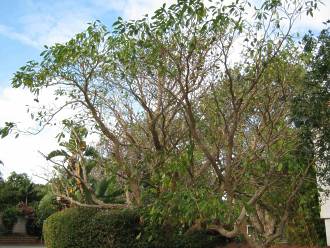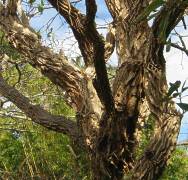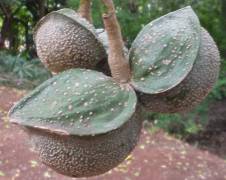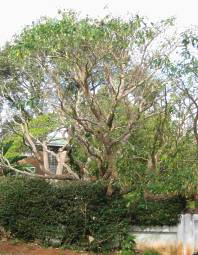Tabernaemontana elegans
Tabernaemontana elegans Stapf
Family: Apocynaceae
Common names: toad tree (Eng.); laeveldse paddaboom (Afr.); umKhahlwana, umKhadlu (Zulu); muchanga (Shona)
SA Tree No: 644
Introduction
Tabernaemontana elegans is a beautiful bushveld tree that can be recognised by its large, glossy leaves, fragrant white flowers and large fruit borne in pairs.

Description
Description
An unarmed shrub or tree mostly 1.5 to 5 m tall but occasionally reaching 12 m. The trunk is 50 to 300 mm thick with a corky, pale brown bark with longitudinal fissures. Twigs have prominent leaf scars that form transverse ridges.

The leaves are leathery, opposite and dark glossy green above and paler beneath. Leaf dimensions vary from 90 to 200 mm by 50 to 70 mm, and are generally 2 to 4 times as long as wide. The petioles are 10 to 25 mm long. The raised midrib and lateral nerves are particularly visible on the underside of the leaf.

Each inflorescence consists of many white, fragrant flowers and is borne on a 30 to 50 mm-long peduncle. Each flower is up to 15 mm wide and is borne on a 4 to 7 mm-long pedicel.

The fruit are in pairs, subglobose, with a green skin that is covered in pale warts. Each fruit is 60 to 70 mm long by 40 to 50 mm wide, with two lateral ridges and one dorsal ridge. The fruit are leathery to woody, with a wall that is 5 to 15 mm thick. When mature, they split open along one side, often while still on the tree, displaying the yellowish pulp inside. Each fruit with its green, warty skin resembles a toad, giving rise to the common name toad tree. Embedded in the yellow pulp are numerous dark brown seeds 14 to 17 mm long by 7 to 9 mm wide.

All parts of the plant are hairless and have a milky sap.
Conservation Status
Status
Tabernaemontana elegans is not threatened in any way.
Distribution and habitat
Distribution description
The toad tree is indigenous to tropical east Africa through to South Africa and Swaziland. It is most commonly encountered along riverbanks, in coastal forest and savanna woodlands.
Derivation of name and historical aspects
History
Jakob Theodor von Bergzabern was a 16th century herbalist who Latinised his name as Tabernaemontanus. Linnaeus named this genus after him. The specific name elegans refers to the tree's elegant appearance.
Ecology
Ecology
Tabernaemotanus elegans is deciduous, losing most of its leaves during the winter. The yellow pulp from the fruit is eaten by people, monkeys, baboons, rhinoceroses, hornbills and white-eared barbets. Flowering time is October to February. Seeds of T. elegans germinate readily, and it is a relatively quick-growing plant. It forms part of the early successional vegetation in subtropical bushveld and coastal forest along southern Africa's east coast. It has been recorded among the weedy shrubs that are first to colonise untended cotton fields in Mozambique.
Uses
Use
Apart from the yellow pulp being eaten on its own, the Zulu people add it to milk to speed up the curdling process. The seeds are also burnt, ground to a powder and mixed with tobacco for chewing or smoking. As a medicinal plant it has a variety of uses. The coagulated milky sap is used as a styptic, and root infusions are drunk as an aphrodisiac as well as a remedy for lung ailments and stomach ache. In addition, a maceration of the roots is taken twice daily to treat tuberculosis. Some venereal diseases are treated with a potpourri of plant material that includes roots of Tabernaemontana elegans. The inner layer of the fruit wall (endocarp) is dried, pulverised and boiled in water. The water is then filtered and taken to treat cancer. Please note that parts of the plant, as administered by traditional healers in their concoctions, have been recorded as toxic.

Growing Tabernaemontana elegans
Grow
T. elegans is a handsome ornamental plant that is easily propagated from seed. It requires full sun and must be well watered. It is half-hardy and young plants should be protected from frost. It is deciduous, losing its leaves in the winter, so the plant does require some maintainance during this time.
References
- Arnold, T.H. et al. (2002). Medicinal and magical plants of southern Africa: an annotated checklist. Strelitzia 13.
- Balsinhas, A.A. (1983). The weeds of abandoned cotton fields in Mozambique. Bothalia 14: 971-975.
- Glen, H.F. (2004). What's in a name? Jacana, Johannesburg.
- Joffe, P. (1993). The gardener's guide to South African plants. Tafelberg, Cape Town.
- Jordaan, M. (1979). Tabernaemontana elegans. Blomplante van Afrika 45(180): t. 1798.
- Neuwinger, H.D. (2000). African traditional medicine: a dictionary of plant use and applications. Medpharm, Stuttgart.
- Palgrave, K.C. (1977). Trees of southern Africa. Struik, Cape Town.
- Palmer, E. & Pitman, N. (1972). Trees of southern Africa, vol. 3: 1915,1917. A.A. Balkema, Cape Town.
- Van Leeuwenberg, A.J.M. (1985). Flora Zambesiaca 7(2): 439-440.
Credits
Michael Cheek
Early Detection and Rapid Response – Invasive Alien Plants
KwaZulu-Natal Herbarium
September 2010
Plant Attributes:
Plant Type: Shrub, Tree
SA Distribution: KwaZulu-Natal, Limpopo, Mpumalanga
Soil type: Sandy, Clay, Loam
Flowering season: Early Summer, Late Summer
PH: Acid, Alkaline, Neutral
Flower colour: White, Cream
Aspect: Shade, Morning Sun (Semi Shade)
Gardening skill: Easy
Special Features:
Horticultural zones









Rate this article
Article well written and informative
Rate this plant
Is this an interesting plant?
User Comments
Leigh Dewar , South Africa
November 25, 2018 at 3:41 PMMy toad tree seems to have died back on one side. It probably needs more water. Can I give it some manure as well?
Thank you
Leigh Dewar
Login to add your Comment
Back to topNot registered yet? Click here to register.